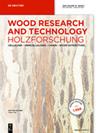用纳米银铜颗粒处理的杨木:真菌降解和沥滤分析
IF 1.6
3区 农林科学
Q2 FORESTRY
引用次数: 0
摘要
本研究探讨了纳米银铜微粒(20 纳米)对 Coriolus versicolor 和 Gloeophyllum trabeum 的抑制作用。使用浓度为 0.01 %、0.02 %、0.03 %、0.05 %、0.075 % 和 0.1 % 的纳米银铜水溶液对杨木样本(杨树)进行真空浸渍。碱性季铵盐铜(ACQ,0.1 %)、硼酸(0.2 %)和未经处理的对照组(CK)被用来进行比较。研究了抗腐烂性和浸出性。比较了纳米银铜、纳米银、Ag+(硝酸银)、Cu2+(硝酸铜)和 Ag+-Cu2+ 复合材料的抗真菌效果。纳米 AgCu 粒子在暴露 12 周后表现出对真菌的有效抵抗力。纳米银铜在杨木上对 C. versicolor 和 G. trabeum 的阈值保留分别为 0.19 kg m-3 和 0.62 kg m-3。纳米银铜粒子表现出优异的耐浸出性,浸出后仍能保持抑制效果。与单一离子或金属纳米粒子相比,纳米银铜粒子具有更好的抗真菌效果。这项研究表明,与商用水溶性防腐剂相比,纳米银铜微粒具有作为高效木材防腐剂的潜力。本文章由计算机程序翻译,如有差异,请以英文原文为准。
Poplar wood treated with nano-silver–copper particles: fungal degradation and leaching analysis
This study investigated the inhibition effect of nanoscale silver–copper particle (20 nm) against Coriolus versicolor and Gloeophyllum trabeum . Poplar wood samples (Populus L.) were vacuum-impregnated using aqueous nano-AgCu solutions at concentrations of 0.01 %, 0.02 %, 0.03 %, 0.05 %, 0.075 %, and 0.1 %. Alkaline copper quaternary (ACQ, 0.1 %), boric acid (0.2 %) and untreated control group (CK) were employed for comparisons. Decay resistance and leachability were studied. The anti-fungi effects were compared between nano-AgCu, nano-Ag, Ag+ (silver nitrate), Cu2+ (copper nitrate), and a composite of Ag+ –Cu2+ . Nano-AgCu particle exhibited effective resistance to fungi after 12 weeks of exposure. The threshold retention of the nano-AgCu against C. versicolor and G. trabeum on poplar wood was 0.19 kg m−3 and 0.62 kg m−3 , respectively. The silver–copper nanoparticles demonstrated excellent leach resistance, and the inhibition effect was retained after leaching. The nano-AgCu particle provided better antifungal effects than single ions or metal nanoparticles. This study illustrates the potential of using nano-AgCu particle as an efficient wood preservative compared to commercial water-soluble preservatives.
求助全文
通过发布文献求助,成功后即可免费获取论文全文。
去求助
来源期刊

Holzforschung
工程技术-材料科学:纸与木材
CiteScore
4.60
自引率
4.20%
发文量
83
审稿时长
3.3 months
期刊介绍:
Holzforschung is an international scholarly journal that publishes cutting-edge research on the biology, chemistry, physics and technology of wood and wood components. High quality papers about biotechnology and tree genetics are also welcome. Rated year after year as one of the top scientific journals in the category of Pulp and Paper (ISI Journal Citation Index), Holzforschung represents innovative, high quality basic and applied research. The German title reflects the journal''s origins in a long scientific tradition, but all articles are published in English to stimulate and promote cooperation between experts all over the world. Ahead-of-print publishing ensures fastest possible knowledge transfer.
 求助内容:
求助内容: 应助结果提醒方式:
应助结果提醒方式:


